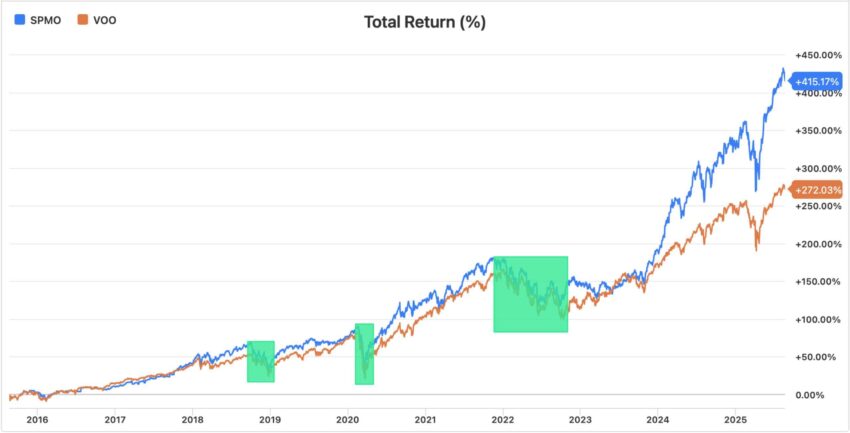Key Points
-
One ETF has been a clear winner this year, with stellar gains.
-
This ETF has had similar downturns to the S&P 500, while delivering significantly higher gains.
-
And it may keep doing so in the future.
-
Are you ahead, or behind on retirement? SmartAsset’s free tool can match you with a financial advisor in minutes to help you answer that today. Each advisor has been carefully vetted, and must act in your best interests. Don’t waste another minute; learn more here.(Sponsor)
Most investors who buy the Vanguard S&P 500 ETF (NYSEARCA:VOO) assume they already own the market’s sweet spot. After all, VOO has become the default choice for anyone who wants the biggest U.S. companies at a fee so low it essentially rounds to zero. VOO is up 8.71% year-to-date as of this writing. That’s a solid return.
A far less famous ETF has delivered 20.14% in gains year-to-date (~130% better than the VOO). This is even better than the 10.4% that the QQQ returned. The Invesco S&P 500 Momentum ETF (NYSEARCA:SPMO) is the ETF in question. It still invests inside the S&P 500, but the index re-weights and puts extra money into the names with the strongest price momentum, cutting loose the laggards.
This has resulted in unbelievably strong performance recently, with drawdowns that are identical or even better than the S&P 500. SPMO’s top holdings now read like a who’s who of this year’s market darlings, and the fund’s rebalancing has caused it to buy high and sell higher.
You may be leaving alpha on the table by ignoring it.
How SPMO outperforms the S&P 500
The ETF tracks the S&P 500 Momentum Index. The index uses sophisticated methodology, as it looks at the past year of price history and then excludes the most recent month to prevent it from chasing very short-term spikes. In turn, this lets it ride sustained momentum.
Plus, it rebalances just twice per year on the third Fridays of March and September. This gives trends time to develop while avoiding the transaction costs of constant trading.
There’s a lot more math going on in the background that would take us out of the scope of this article, but the methodology has worked wonderfully. On that note, let’s take a look at how it has performed.
SPMO is not a one-trick pony
As I mentioned previously, the drawdowns here are quite comparable to the S&P 500, even though it has delivered more returns. That’s because SPMO doesn’t exclusively chase growth stocks and comes with diversification. The kind of diversification it has is closer to optimal, since the benefits of diversification keep diminishing past 30-40 stocks. SPMO holds 100 vs. the VOO’s 507.
Here are its top holdings.
Now, let’s look at some examples of how SPMO has done vs. VOO during previous downturns.
In each major downturn in the past, SPMO has managed to stay ahead of VOO. In the spring correction this year, SPMO declined more, and it was only by a bit over 1%. The gains it has since delivered more than make up for it.
But does this mean you should switch over from VOO to SPMO immediately? Not at all.
The cost of chasing momentum
The most visible caveat is that SPMO has an expense ratio of 0.13%, or $13 per $10,000, vs. VOO’s 0.03% fee, or just $3 per $10,000. That might look trivial. But let’s assume that on a $100,000 investment, you pay $130 annually to SPMO versus just $30 to VOO. Over 20 years, assuming 7% annual returns, this fee difference alone costs you approximately $7,131.
VOO also gives you a higher dividend yield at 1.19% vs. SPMO’s 0.57%. You again lose out on more compounded dividend income. And unlike VOO, SPMO has a relatively short history. It was launched in 2015, so it is still untested in a true recessionary environment. If the AI rally were to reverse suddenly shortly after its rebalancing, you’d have to wait for six more months until SPMO exits. But again, you’d have to be very unlucky for things to unfold in that manner.
Should you buy SPMO?
I’d be willing to look over those caveats in return for the performance you are getting. SPMO should roughly match or slightly underperform the VOO in down cycles, as it has done in the past. But in bull markets, the momentum focus will allow it to outperform greatly.
SPMO makes the strongest case for investors with long-term horizons and high risk tolerance who want systematic exposure to momentum as a factor. If you think the AI rally is here to stay and tech will continue spearheading the economy, it’s worth buying as a satellite holding.
The post 1 Secret ETF That Outperformed the VOO by 130% Year-To-Date appeared first on 24/7 Wall St..
Click this link for the original source of this article.
Author: Omor Ibne Ehsan
This content is courtesy of, and owned and copyrighted by, https://247wallst.com and its author. This content is made available by use of the public RSS feed offered by the host site and is used for educational purposes only. If you are the author or represent the host site and would like this content removed now and in the future, please contact USSANews.com using the email address in the Contact page found in the website menu.





